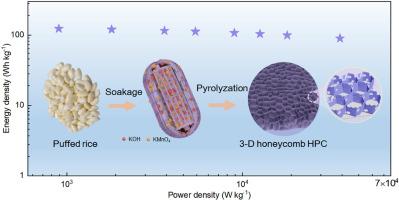Engineering biomass heterogeneity of puffed rice into optimal pore topology for high-performance supercapacitors
IF 7.9
2区 工程技术
Q1 CHEMISTRY, PHYSICAL
引用次数: 0
Abstract
Rational pore architecture—featuring optimal size distribution, interconnected frameworks, and maximized accessible surface area—is critical to achieve high energy density without compromising power density. Biomass-derived porous carbons are known for their natural hierarchical porosity, self-doped heteroatoms, cost-effectiveness, and sustainability, yet suffering from unbalanced macro-/micro-pore ratios and unresolved template-activation tradeoffs. Herein, we report a puffed rice-derived three-dimensional honeycomb-like hierarchical porous carbon (HPC) via synergistic KOH activation and MnO sacrificial templating, producing an interconnected porous network with an ultrahigh specific surface area (3107 m2 g−1) and optimized ion transport pathways. The HPC delivers capacitances as high as 676 F g−1 (1 A g−1, three-electrode) and 409 F g−1 (0.1 A g−1, two-electrode) in 6 M KOH, with outstanding rate capability (75.3 % retention at 10 A g−1) and cycling stability (93.7 % retention after 100,000 cycles). As a symmetric supercapacitor using EMIMBF4 electrolyte, HPC achieves 123.8 Wh kg−1 at 450 W kg−1 and retains 104 Wh kg−1 even at 12,600 W kg−1. This work represents a paradigm shift in biomass utilization by converting inherent biological heterogeneity into a structural advantage through controlled pore engineering.

膨化水稻的生物质能异质性工程转化为高性能超级电容器的最佳孔隙拓扑结构
合理的孔隙结构——具有最佳的尺寸分布、相互连接的框架和最大的可达表面积——是在不影响功率密度的情况下实现高能量密度的关键。生物质衍生的多孔碳以其天然的分层孔隙度、自掺杂杂原子、成本效益和可持续性而闻名,但存在不平衡的宏/微孔比和未解决的模板活化权衡。在这里,我们报道了一种膨化的大米衍生的三维蜂窝状分层多孔碳(HPC),通过协同KOH活化和MnO牺牲模板,产生了一个具有超高比表面积(3107 m2 g−1)和优化离子运输途径的互连多孔网络。HPC在6 M KOH条件下可提供高达676 F g−1 (1 A g−1,三电极)和409 F g−1 (0.1 A g−1,两电极)的电容,具有出色的倍率能力(在10 A g−1下保持75.3%)和循环稳定性(10万次循环后保持93.7%)。作为使用EMIMBF4电解液的对称超级电容器,HPC在450w kg - 1时达到123.8 Wh kg - 1,即使在12600w kg - 1时也保持104 Wh kg - 1。这项工作通过控制孔隙工程将固有的生物异质性转化为结构优势,代表了生物质利用的范式转变。
本文章由计算机程序翻译,如有差异,请以英文原文为准。
求助全文
约1分钟内获得全文
求助全文
来源期刊

Journal of Power Sources
工程技术-电化学
CiteScore
16.40
自引率
6.50%
发文量
1249
审稿时长
36 days
期刊介绍:
The Journal of Power Sources is a publication catering to researchers and technologists interested in various aspects of the science, technology, and applications of electrochemical power sources. It covers original research and reviews on primary and secondary batteries, fuel cells, supercapacitors, and photo-electrochemical cells.
Topics considered include the research, development and applications of nanomaterials and novel componentry for these devices. Examples of applications of these electrochemical power sources include:
• Portable electronics
• Electric and Hybrid Electric Vehicles
• Uninterruptible Power Supply (UPS) systems
• Storage of renewable energy
• Satellites and deep space probes
• Boats and ships, drones and aircrafts
• Wearable energy storage systems
 求助内容:
求助内容: 应助结果提醒方式:
应助结果提醒方式:


